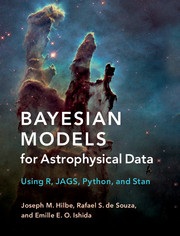Book contents
- Frontmatter
- Dedication
- Contents
- Preface
- 1 Astrostatistics
- 2 Prerequisites
- 3 Frequentist vs. Bayesian Methods
- 4 Normal Linear Models
- 5 GLMs Part I – Continuous and Binomial Models
- 6 GLMs Part II – Count Models
- 7 GLMs Part III – Zero-Inflated and Hurdle Models
- 8 Hierarchical GLMMs
- 9 Model Selection
- 10 Astronomical Applications
- 11 The Future of Astrostatistics
- Appendix A Bayesian Modeling using INLA
- Appendix B Count Models with Offsets
- Appendix C Predicted Values, Residuals, and Diagnostics
- References
- Index
- Plate section
- References
1 - Astrostatistics
Published online by Cambridge University Press: 11 May 2017
- Frontmatter
- Dedication
- Contents
- Preface
- 1 Astrostatistics
- 2 Prerequisites
- 3 Frequentist vs. Bayesian Methods
- 4 Normal Linear Models
- 5 GLMs Part I – Continuous and Binomial Models
- 6 GLMs Part II – Count Models
- 7 GLMs Part III – Zero-Inflated and Hurdle Models
- 8 Hierarchical GLMMs
- 9 Model Selection
- 10 Astronomical Applications
- 11 The Future of Astrostatistics
- Appendix A Bayesian Modeling using INLA
- Appendix B Count Models with Offsets
- Appendix C Predicted Values, Residuals, and Diagnostics
- References
- Index
- Plate section
- References
Summary
The Nature and Scope of Astrostatistics
Astrostatistics is at the same time one of the oldest disciplines, and one of the youngest. The Ionian Greek philosopher Thales of Miletus is credited with correctly predicting a total solar eclipse in central Lydia, which he had claimed would occur in May of 585 BCE. He based this prediction on an examination of records maintained by priests throughout the Mediterranean and Near East. The fact that his prediction was apparently well known, and the fact that the Lydians were engaged in a war with the Medes in Central Lydia during this period, brought his prediction notice and fame. Thales was forever after regarded as a sage and even today he is named the father of philosophy and the father of science in books dealing with these subjects.
Thales’ success spurred on others to look for natural relationships governing the motions of astronomical bodies. Of particular note was Hipparchus (190–120 BCE) who, following on the earlier work of Aristarchus of Samos (310–230 BCE and Eratosthenes (276–147 BCE), is widely regarded as the first to clearly apply statistical principles to the analysis of astronomical events. Hipparchus also is acknowledged to have first developed trigonometry, spherical trigonometry, and trigonometric tables, applying these to the motions of both the moon and sun. Using the size of the moon's parallax and other data from the median percent of the Sun covered by the shadow of the Earth at various sites in the area, he calculated the distance from the Earth to the Moon as well as from the Earth to the Sun in terms of the Earth's radius. His result was that the median value is 60.5 Earth radii. The true value is 60.3. He also calculated the length of the topical year to within six minutes per year of its true value.
Others in the ancient world, as well as scientists until the early nineteenth century, also used descriptive statistical techniques to describe and calculate the movements and relationships between the Earth and astronomical bodies. Even the first application of a normal or ordinary least squares regression was to astronomy. In 1801 Hungarian Franz von Zach applied the new least squares regression algorithm developed by Carl Gauss for predicting the position of Ceres as it came into view from its orbit behind the Sun.
- Type
- Chapter
- Information
- Bayesian Models for Astrophysical DataUsing R, JAGS, Python, and Stan, pp. 1 - 8Publisher: Cambridge University PressPrint publication year: 2017



